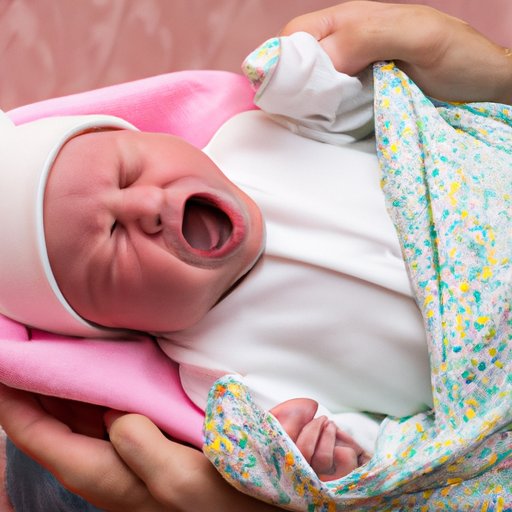
Introduction
One of the many challenges of being a new parent is learning how to soothe and comfort a crying newborn. In addition to feeding and diaper changes, burping your baby after feeding is an important step in ensuring their comfort and health. Newborns swallow air while feeding, which can cause trapped gas and discomfort. In this article, we will explore the different methods and positions for burping a newborn and provide step-by-step instructions and tips for success.
Different Positions Suitable for Burping a Newborn
There are various positions that can be used to burp a newborn, including over the shoulder, on your lap, and sitting upright. Each has their pros and cons, and the best position may vary depending on the baby’s size and personal preference.
Over the Shoulder
This is a common position and involves holding your baby facing away from you, with their chin on your shoulder. Use one hand to support the baby’s bottom and the other hand to gently pat or rub their back. This position is ideal for smaller infants.
On Your Lap
In this position, sit your baby on your lap with their head slightly higher than their body. Use one hand to support their chin and chest while the other hand pats or rubs their back. This position works well for larger babies and those who may have reflux.
Sitting Upright
This position is particularly effective for babies who are already able to sit upright with assistance. Sit your baby on your lap or in a high chair and support their chest and neck. Gently pat or rub their back while holding them upright.
Step-by-Step Instructions on How to Burp a Newborn
Regardless of the position you choose, ensure that your baby is comfortable and supported. It’s essential to be gentle and patient when burping your newborn to avoid injury.
Over the Shoulder Position
- Hold your baby facing away from you, with their chin on your shoulder.
- Use one hand to support the baby’s bottom while the other hand pats or rubs their back gently.
- Aim for the middle of their back, where their spine meets their ribs, and avoid hitting their lower back too hard.
- Continue patting or rubbing until the baby burps or appears relaxed.
On Your Lap Position
- Sit your baby on your lap with their head slightly higher than their body.
- Support their chin and chest with one hand while the other hand pats or rubs their back gently.
- Aim for the middle of their back, where their spine meets their ribs, and avoid hitting their lower back too hard.
- Continue patting or rubbing until the baby burps or appears relaxed.
Sitting Upright Position
- Sit your baby on your lap or in a high chair and support their chest and neck.
- Gently pat or rub their back while holding them upright.
- Aim for the middle of their back, where their spine meets their ribs, and avoid hitting their lower back too hard.
- Continue patting or rubbing until the baby burps or appears relaxed.
Tips and Tricks for Burping a Newborn
Burping a newborn can be intimidating, but there are many tips and tricks to make it easier. Remember to be gentle and patient, and don’t be afraid to change positions or take breaks if needed.
Gentle Patting or Rubbing the Baby’s Back
A light but firm pat or rub on the baby’s back can help stimulate the release of trapped gas. Be careful not to pat too hard, which can cause discomfort or injury.
Changing the Position if Burping Doesn’t Happen
If your baby isn’t burping after a few minutes, it may be time to try a different position. Experiment with different positions until you find what works best for your baby.
Waiting for a Few Minutes Before Trying Again
If the baby doesn’t burp after a few minutes, it’s okay to take a break and try again later. Be patient and let the baby relax before attempting to burp again.
Common Mistakes Parents Make When Burping Their Newborns
Burping a newborn is a delicate procedure, and it’s easy to make mistakes. Here are some common mistakes to avoid:
Being Too Rough
It’s important to be gentle when burping your newborn to avoid injury. Avoid hitting the baby’s back too hard or being too forceful.
Patting Too Hard
While patting the baby’s back can help release trapped gas, it’s crucial to avoid patting too hard to avoid causing discomfort or harm. Instead, use a light but firm pat or rub.
Burping Too Frequently
While it’s important to burp the baby after feeding, it’s unnecessary to do so after each feeding. Try burping your baby every 2-3 ounces or whenever they seem fussy or uncomfortable.
Additional Advice on How to Prevent Gas and Colic in Newborns
While burping is essential, there are other steps you can take to prevent gas and colic in your newborn.
Feeding in an Upright Position
Feeding your baby in an upright position can help prevent air from being swallowed during feeding. Consider using a breastfeeding pillow or bottle holder to achieve the proper position.
Avoiding Overfeeding
Overfeeding your newborn can lead to excess gas and discomfort. Follow your baby’s cues and stop feeding when they show signs of being full.
Using a Slower-Flow Nipple
If your baby is bottle-fed, consider using a slower-flow nipple to prevent excess air from being swallowed while feeding.
Conclusion
Burping a newborn is a crucial step in ensuring their comfort and health. Be patient, gentle, and don’t be afraid to experiment with different positions. Remember to avoid common mistakes, and take steps to prevent gas and colic in your baby. By following these tips and tricks, you can help your newborn thrive and stay comfortable.




